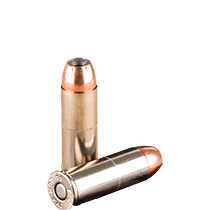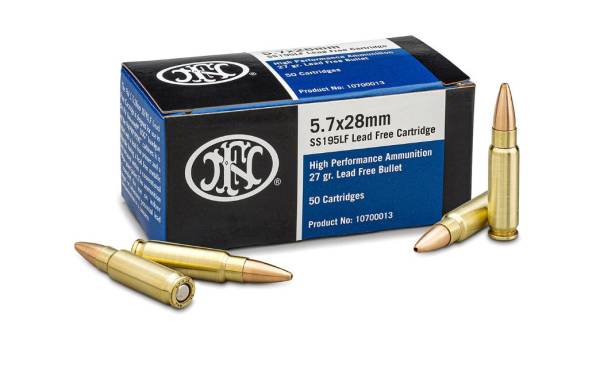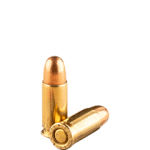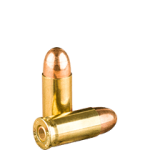Description
The .44 S&W Special has been called one of the most accurate and versatile cartridges ever made, yet its popularity never soared as high as other revolver rounds. Even so, the .44 Special, as it’s commonly called, has withstood the test of time over 100 years since its conception, and can still be found on gun store shelves across America. This cartridge provides shooters a round that they can use for self defense, hunting, target shooting, and recreational fun.
Development of the .44 S&W Special
At the turn of the 20th century, Smith & Wesson wanted to release a new revolver and decided to create a new caliber for the gun. For the 1908 “triple lock” .44 Hand Ejector, also known as the 1st Model New Century Revolver, S&W started with the .44 S&W Russian, an ammunition created in 1870 as a military revolver for the Imperial Russian Army, and set out to improve on its features.
S&W decided to opt for smokeless powder, the newest ammunition innovation of the time, instead of the traditional black powder used in the .44 Russian. Yet the quantity of smokeless powder far exceeded the black powder used in the older cartridge, so S&W lengthened the ammo’s casing by .19 inch to make room for six more grain (gr) of powder. This change created slightly more power with the same size bullet, but otherwise the round mimicked the .44 Russian’s accuracy and performance ballistics.
The .44 Special: A Reloader’s Dream
When it comes to factory loads, the large bore .44 Special cartridge has never reached its full capacity. Soon after its release, handloaders started reloading the thick brass shells of the .44 Special to higher standards.
By the 1920s, these handloaders became known as the “44 Associates” and included such famous reloaders as Elmer Keith and Skeeter Skelton. The 44 Associates and their fans started trading their own loading specs, making ammunition designed for greater self defense and hunting ability than the .44 Special factory loads.
Even today, there’s plenty of people out there handloading .44 Special ammo, nearly 100 years later, and for good reason. Not only does the cartridge provide a wide range of versatility, it also uses a large bullet and a large casing. This makes reloading significantly easier than with smaller bullets and shells, even when compared to the .38 Special or 9mm Parabellum. Reloading this ammo gives shooters the ability to have cheap .44 Special bulk ammo without sacrificing safety and reliability.
Elmer Keith and .44 Special Ammo
Elmer Keith, perhaps one of the world’s most famous gun writers, was one of the biggest advocates for the .44 Special. While he was an avid fan of the ammunition, Keith wanted a revolver hunting round that could handle most anything the wilds of North America produced. And while the .44 Special didn’t have that much kick, Keith recognized that it could.
A handloader, Keith started modifying the .44 Special, continually using heavier loads and heavier bullets. He knew the cartridge could withstand higher pressures than ammunition manufacturers were using and even lobbied then to make the load hotter, but never succeed in his request.
Finally, in 1955, after going to Smith & Wesson with his case, Keith found what he wanted. Smith & Wesson, in collaboration with Remington Arms Company, lengthened the .44 Special case and added more powder and pressure, creating the .44 Magnum, a cartridge that has proved more popular over the years than its parent.
.44 Special vs. .44 Magnum
While the .44 Special and .44 Magnum are different cartridges, they’re extremely similar. Both the .44 Special and the .44 Mag have the same diameter lead bullet (.429 inch) in a case the same diameter (.457 inch) and thickness (.060 inch).
The most significant visible difference is the length of the casing. The .44 Mag took the Special case and made it slightly longer. While many believe this is for added powder, that’s not the case (the original .44 Special case has plenty of room for more powder). Instead, the case was lengthened to stop accidental loading of the .44 Magnum in older revolvers chambered for the Special ammunition. Manufacturers were concerned that the older firearms may not withstand the velocity and muzzle energy of the new load and, therefore, made it so the rounds wouldn’t fit into the gun’s cylinder.
Beyond the case length, the major difference between the .44 Special and .44 Magnum results from the Magnum having a higher pressure. According to the ammunition standards set by SAAMI, the .44 Special has a maximum pressure of 15,500 psi while the .45 Mag is rated with a max of 36,000 psi. With more than double the pressure, the .44 Mag has a higher velocity, a stronger muzzle velocity, and a whole lot more bang.
Different Types of .44 Special Ammunition
The .44 Special round performs well in its own right. Today’s commercial ammunition offers bullet weights between 135 and 255 gr. In the standard 200 gr round, muzzle velocity can reach 700 feet per second (fps) to 1,000 fps and a muzzle energy of over 300 foot pound force (ft·lb).
Shooters can find a wide range of .44 Special ammunition manufacturers and types. Federal, Hornady, Remington, and Magtech, among others, make these rounds in a variety of forms. Some of the most common include:
Lead round nose (LRN): LRN ammunition is a standard ammo featuring a round, lead bullet that sits in a brass or steel case. These rounds can be used for a variety of shooting goals from personal protection to plinking steel in the backyard. They feed well, deform on impact more than standard full metal jacket (FMJ) bullets, and provide affordable options – especially when .44 Special ammo bulk pricing is available.
Lead flat nose (LFN): LFN rounds are similar to the LRN, except the lead bullets have a flat nose. This type of .44 Special ammo is often used for target and match shooting, as it cuts through paper targets much like a wadcutter bullet, making it easier to score. They also have a lighter load of powder, which gives the bullet less velocity, but makes it easier to shoot for those who struggle with recoil, such as novice or senior shooters. In addition to target rounds, some people opt for FLN ammo for home defense, as the flat tip leads to a greater expansion than LRN and, therefore, has more stopping power.
Jacketed hollow points (JHP): JHP ammo features a lead bullet jacketed in a harder metal, typically copper. This jacket helps the bullet keep its shape throughout its trajectory. Unlike FMJ, JHP ammo also has a hollowed point inside the bullet, which allows it to expand on impact, creating a greater impact wound and reducing the projectile’s risk of over-penetration.
Lead semi-wadcutter hollow point (LSWCHP): Although it’s a mouthful, the LSWCHP is a useful, general purpose ammunition. Designed as a semi-wadcutter, it’s great for target shooting and, because it “cuts” through the paper instead of tearing like more traditional FMJ bullets, this ammo makes scoring targets easier and more consistent. Since these rounds have a lower pressure and lighter load, they’re often easier to shoot. The tapered nose and flat point of LSWCHP ammo makes them more versatile than full wadcutters, and they’re always an appropriate round at the range or for self defense.
Glaser safety slugs: Made by Cor-Bon, these are specialty self-defense rounds based on the need of U.S. Air Marshals. The Marshals needed a duty ammunition that was safe to shoot on a plane without the risk of over-penetration or ricochet. This ammunition features a jacketed bullet filled with pre-fragmented projeticles inside.
Cowboy loads: When it comes to .44 Special cowboy ammo, there are different makes and models that share similar features – most notably, a lighter, easier-to-handle load. This ammo’s designed for use in older .44 Special revolvers, which may not withstand the power and force of modern ammunition.
Popular .44 Special Revolvers
While .44 Special ammo has withheld the test of time, the range of firearms available for the caliber has ebbed and flowed throughout the last century. Yet within the last two decades, guns chambered for .44 Special ammunition has seen a resurgence.
Some of the most iconic, reliable, and accurate firearms for the .44 Special include:
Smith & Wesson Triple Lock: The first gun chambered for the .44 Special, Smith & Wesson manufactured the New Century for only seven years. Production on the revolver was stopped in 1915, with only 15,000 total firearms made, each with a retail price of $21. Find one of these in a gun store today, and that price is exponentially higher.
Smith & Wesson Model 24: Known as both the Model 24 and Model 1950, depending on the year the revolver in question was manufactured, the Model 24 remained in production until 1966, although since then, multiple “specialty” runs have occured. The company even created a stainless steel version called Model 624. Both of these models come in multiple barrel sizes, and the Model 24 was a favorite of gun guru Skeeter Skelton.
Ruger Blackhawk: When it comes to modern revolvers, the Ruger Blackhawk Bisley is a nice option. A six-shot wheel gun, the Blackhawk is made from stainless steel and has a traditional, western-style grip and feel. It’s great for recreational shooting and has target-grade accuracy.
Charter Arms Bulldog: For someone who wants to carry a .44 Special for personal protection, try the Charter Arms Bulldog. An affordable .44 Special revolver, this gun has a rugged reliability and more than efficient stopping power. It has the power expected of a .44 caliber weapon, but with the size and weight that makes concealed carry easy.
.44 Special Bullets: More Popular Than the Guns Chambered for Them
Part of the longevity of the .44 Special, in spite of being superseded by the .44 Magnum, is that it can be fired in revolvers chambered for the .44 Mag. The relationship between the .44 Special and the .44 Magnum is much like that of the .38 Special and the .357 Magnum. In both cases, the Magnum ammunition was born from the Special and given a longer casing to avoid any accidental loadings of the more powerful ammo.
Also, when it comes to revolvers, those chambered for Magnum can hold and shoot the Special ammo, meaning a .38 Special can be shot from a .357 Mag revolver, just as a .44 Special can be fired from a .44 Magnum revolver, but not vice versa. Shooting the Special load from the Magnum handgun gives the shooter less recoil and muzzle energy, making the round easier on the shooter’s hands, as well as the firearm in question.
While the firearms for the .38 Special remained popular after the release of the .357 Mag, the same can’t be said for .44 Special revolvers. With the help of Clint Eastwood’s Dirty Harry, the Magnum skyrocketed with pop culture, while the Special fell to the wayside.
There are many considerations when it comes to what influences a firearm’s popularity. Many believe that the .38 Special remained favorable because the higher maximum pressure allowance from SAAMI, which included a +P as standard, offered shooters a much greater variety of loads than with the .44 Special, which standard was left low.
With modern bullet technology, .44 Special ammunition is again rising in popularity, although there hasn’t been an increased interest in the firearms themselves. That’s because so many shooters are turning to the .44 Special for use in their .44 Mag revolvers. Not only is it easier to handle, but modern commercial ammo offers a full range of personal-defense ammo in the caliber – and the price of .44 Special bulk ammo is often cheaper than .44 Mag.
.44 Special vs. .45 ACP
When it comes to caliber comparisons, the .44 Special vs. .45 ACP remain close, even though the former was designed for a revolver and the latter for a semi-automatic pistol. John Browning created the .45 Automatic Colt Pistol (ACP) cartridge in 1905, two years before Smith & Wesson released the .44 Special.
The bullet of the .45 ACP is slightly larger than the .44 Special (.451 inch compared to .429 inch), but sits in a shorter case with the ACP ammo having a total length of 1.275 inches and the .44 Special measuring in at 1.615 inches.
Performance-wise, the calibers are neck and neck. With a 230 gr FMJ bullet, the .45 ACP reaches an average velocity of 835 fps with a muzzle energy of 356 ft·lb, while a .44 Special 200 gr semi-wadcutter bullet can reach a velocity of 870 fps and a muzzle energy of 336 ft·lb.
Some would say the benefit of the .45 ACP isn’t found in its ballistics, but in the fact that it’s a magazine-fed, semi-automatic pistol, which allows for significantly more ammunition and offers a quicker and more effective reload than the .44 Special, which is often found in five- and six-shot revolvers. The counter argument, in favor of the .44 Special, addresses the fact that revolvers, in general, tend to be more reliable and don’t have issues with feeding or misfires.
FAQ
What is .44 S&W Special ammo?
The .44 S&W Special round is a powerful revolver cartridge used for self defense and hunting. Known as both the .44 S&W and the .44 Special, this ammo is the parent round for the .44 Magnum.
What is the difference between .44 Special and .44 Magnum ammo?
The .44 Special was the inspiration for the .44 Magnum, which originally started as a wildcat round. The Magnum shares the same .429 inch diameter bullet as the Special, but it’s 40 grain heavier and in a casing nearly half an inch longer. The .44 Mag is loaded to more than twice the pressure and ballistically, it has more velocity and muzzle energy than the Special.
What is the best 44 Special ammo for home defense?
Just about any .44 Special ammo is suitable for home defense, as even full metal jacket .44 Special rounds carry a deadly force. But FMJ bullets can over penetrate and if that’s a concern, consider a jacketed hollow point that expands on impact, reducing the risk. If the .44 Special has too much recoil for some shooters, such as women or seniors, consider lead flat nose rounds, which have less powder and are easier to manage.
Is the 44 Special equivalent to other ammo calibers?
The .44 Special shares some similarities with other calibers, most notably, the .44 Magnum, which is its parent case. The Special cartridge is also comparable to the .45 ACP in projectile size and ballistic performance. The round is popular among handloaders and has spawned various wildcat rounds.
What is the best 44 Special ammo to use on small game?
Depending on the hunter’s circumstances, a .44 Special for small game may not be the best option, as it could destroy much of the meat on a rabbit or squirrel. The .38 Special offers more than enough stopping power for small game hunting. If you do use a .44 Special, consider a round nose bullet for the least damage.
Spawned from the .44 S&W Russian, .44 Special ammo is a rimmed, centerfire cartridge featuring a .429-inch diameter bullet sitting in a case that’s .457 inch wide and 1.16 inches long. The full ammo reaches a length of 1.615 inches and uses a large pistol primer. According to the Sporting Arms and Ammunition Manufacturers’ Institute (SAAMI), the organization that sets the standard for modern ammunition, the .44 Special’s maximum load is 15,500 pounds per square inch (psi), although many handloaders would disagree with this standard.





